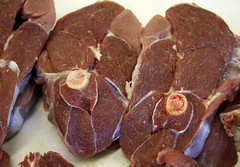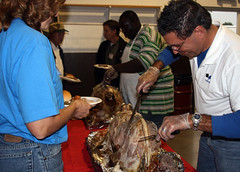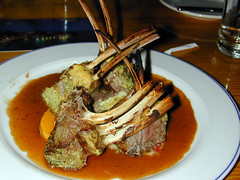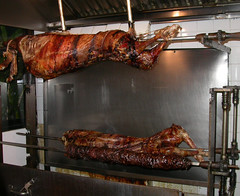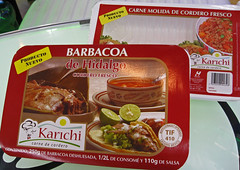Fresh American Lamb
Nutrient-dense
Lamb is a prime source of high-quality protein, vitamins,
and minerals. As with other red meats, its protein is nutritionally
complete, with all eight essential amino acids in the proper ratios.
A 3-ounce serving of lamb provides 43 percent of an adult male's
recommended daily allowance (RDA) of protein. Lamb is high in
B vitamins, zinc, and iron. Red meats, especially lamb and beef,
are amongst the best sources of absorbable iron (heme iron). For those watching
their carbohydrate intake, lamb has zero carbs.
Lean and mean
Compared to other meats, lamb contains very little marbling
(fat in the meat). Since lamb fat is on the edges of the meat,
it is easily trimmed off, which means fewer calories, only 175
in an average 3-ounce serving or 7 percent of the average daily
caloric intake recommended for a 23 to 50-year old male. Only
about 36 percent of the fat in lamb is saturated fat. The rest
is mono or polyunsaturated fat, the "good" fat in one's
diet.
| FDA definition of lean
(3 oz) |
Average value for cooked
lamb (3 oz) |
| < 10 g of total fat |
8 g of total fat |
| < 4.5 g saturated fat |
3 g of saturated fat |
| < 100 mg cholesterol |
80 mg cholesterol |
| Source: American
Lamb Board |
Good fat
Lamb contains varying amounts of fat, depending upon how much the carcass has been trimmed, as well as the lamb's diet, age, sex, and feed. Lamb fat is mostly saturated and monosaturated, with small amounts of polyunsaturated. Lamb tallow contains a family of fats known as ruminant trans fats. Unlike trans fats contained in processed foods, ruminant trans fats are believed to be beneficial to human health. The most common ruminant trans fat is conjugated linoleic
acid (CLA). Lamb contains more CLA than beef or veal.
For the health of it
For years, red meat consumption was blamed for all sorts of human ailments, but especially cardiovascular disease and cancer. Finally, scientists have backed off of this claim, admiting it was based on flimsey evidence. In fact, there is no strong evidence linking red meat consumption with heart disease or cancer. Red meat, including lamb, should be part of a healthy, varied diet.
Lamb vs. mutton
The meat from a young sheep (less than 12 months of age) is
called lamb. It is naturally tender and mild in flavor. The meat
from an older sheep (over one year of age) is called mutton. It
has a more intense flavor than lamb, but is preferred to lamb
in some cultures. Yearling mutton is the meat from a sheep that
is between one and two years of age. It is intermediate in flavor
intensity between lamb and mutton.
Flavor
There is no flavor difference in the meat from a young intact
male and the meat from wethers (castrated male lambs) and ewe
lambs. As rams sexually mature, their hormones may cause a slight
taint in the taste of the meat. Mature rams are more difficult
to harvest than ewes and wethers. In some cultures, the meat from
intact males is preferred to the meat from females and castrates.
Sometimes, an unblemished lamb is required for slaughter.
The sacrificial lamb
Since ancient times, lamb has been regarded as a religious
symbol. Jesus is often referred to as the "Lamb of "God."
Sheep were commonly used for sacrifice. Lamb was served during
the Last Supper. Lamb is traditionally eaten at Easter (especially
Orthodox or Greek) and Passover.
Muslims (followers of Islam) are probably the largest consumers
of sheep meat in the World. Lamb is commonly consumed by Muslims during
their major holidays. During Eid al-adha (the Festival of Sacrifice),
it is common for Muslim families to sacrifice a lamb in commemoration
of Abraham's sacrifice of a lamb in place of his son. The meat
is divided into thirds and shared with family, friends, and the
poor. Lamb is also widely consumed during Ramadan (month of fasting) and Eid al-Fitr (the Festival of fast breaking). It is also common for Muslims to sacrifice lambs to celebrate
the birth of a child (two lambs for a boy child; one for a girl).
The sacrifice is part of the traditional "aqiqah" ceremony.
Per capita consumption
The world per capita consumption of lamb is approximately 4.17 lbs. (2007, AGMRC). The per capita consumption in Australia and New Zealand is 26 and 25 lbs., respectively. In Africa, it is about 5.5 lbs. In recent years, the per capita consumption of sheep meat has increased in Asia and Mexico, due to increasing personal incomes and urbanization. Lamb and mutton are the primary source of animal protein in regions in North Africa, the Middle East, India, and parts of Europe.
In the U.S., the per capita consumption of lamb (and mutton) is
very low, less than one pound per person (0.7-0.8). However, many of today's immigrants to the U.S.
originate from regions of the world where lamb (and goat) are
commonly consumed. Thus, the U.S. continues to import lamb to
meet consumer demand. In fact, lamb imports acccount for about one-third of U.S. lamb consumption. There is a growing demand for lamb in the
U.S., especially among people of specific ethnic backgrounds. In recent years, there has been an up-tick in the consumption of lamb in the US.
<== SHEEP PRODUCTS

